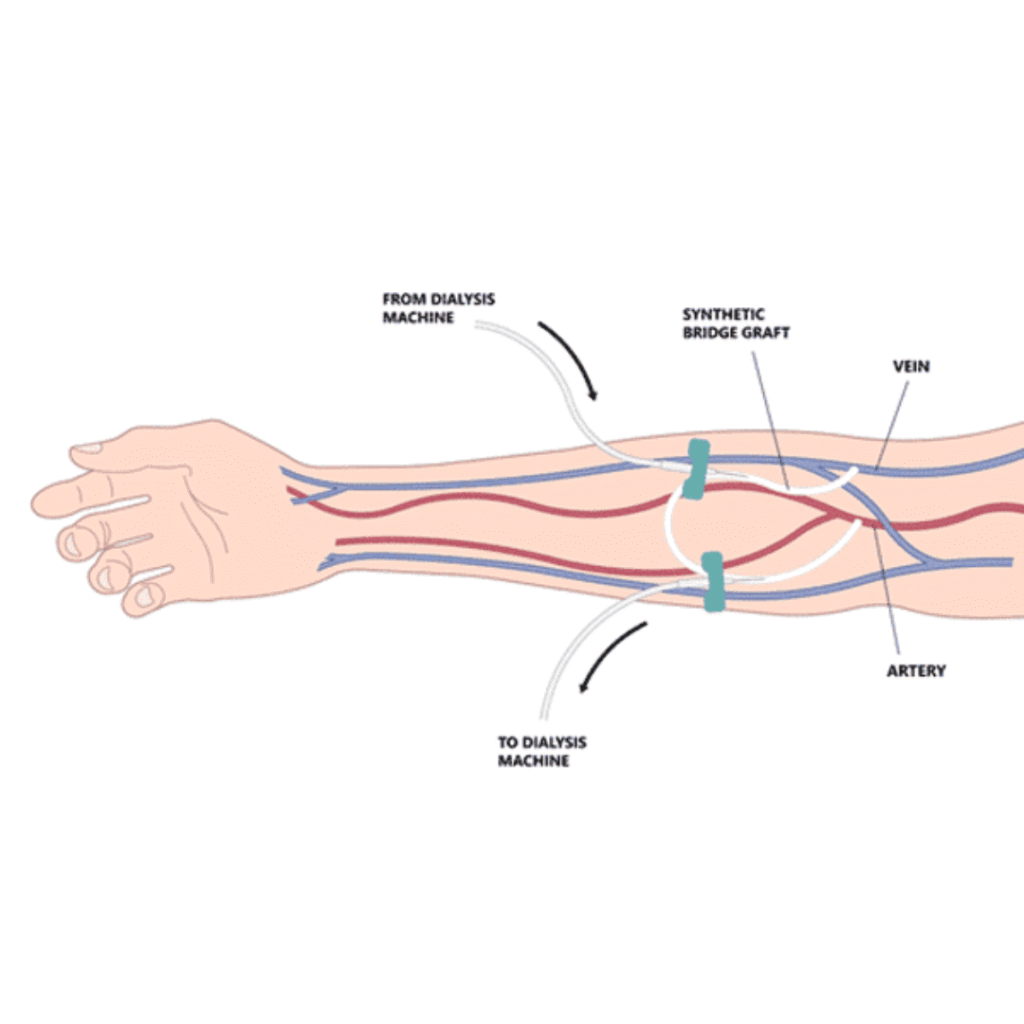AB Graft (ABG – Arteriovenous Graft)
Confidence Begins with Expert Care
Satisfied Patients
Year of Experience
Satisfied Patient
Awards
What is AB Graft?
Gynecomastia is a benign enlargement of male breast glandular tissue, caused by an imbalance between the hormones estrogen and testosterone. It’s relatively common and can affect males of all ages — from newborns to older men.
What causes it:
- Chronic kidney disease (CKD) or end-stage renal disease (ESRD) requiring long-term dialysis
- Inability to create a native AV fistula due to Narrow or scarred veins; Previous failed fistulas; Poor vascular anatomy
- Urgent need for dialysis access
Symptoms:
- Thrill or bruit (vibration or sound) at the graft site — indicates blood flow
- Swelling, redness, or warmth — may suggest infection
- Pain or discomfort at the graft area
- Decreased dialysis efficiency — could indicate graft clotting or narrowing
Complete Process
Evaluation & Imaging
We begin with detailed clinical evaluation, imaging (MRI, CT, fistulogram), and lab work to determine the type, size, and cause of the fistula.
Surgical Planning
Based on the location and complexity, we select one of the following:Fistulotomy , Seton placement , Flap repair , Colostomy diversion.
Surgery & Healing
Most fistula repairs are done under regional or general anesthesia. Depending on the case, hospital stay may range from 1–5 days. Wound care and antibiotics are part of recovery.
Post-Op Monitoring & Support
We monitor healing progress, manage pain, and address continence or scarring concerns through regular follow-ups.
AV Graft (ABG – Arteriovenous Graft)
Why Choose Us for AV Graft (ABG – Arteriovenous Graft)?
- Experienced vascular access surgeons
- Minimal-scar surgical approach
- High graft patency rates
- Pre-operative vascular mapping for optimal outcomes
- Personalized post-op care and training for patients and caregivers
- Emergency management for failed grafts or complications


Need Help?
Patient Recovery & Care Tips
- Always wash the graft site with soap and water
- Avoid sleeping on or compressing the graft arm
- Monitor for pain, redness, or pus around the site
- Report decreased thrill
- Report any unusual discharge or fever immediately
- Never let blood pressure
Get In Touch!
We Would Love to Hear from You!
If you’re considering ABG and seeking expert, personalized treatment, contact us today for a private consultation.
+91-98765-43210
info@astheticplasticsurgery.com
Asthetic Plastic Surgery 2nd Floor, Wellness Plaza South Extension, New Delhi – 110049
Testimonials
Hear directly from our patients as they share their personal journeys—how expert care, advanced procedures, and compassionate support helped them regain confidence and improve their quality of life. These testimonials reflect the transformative impact of our work and the dedication we bring to every patient’s experience.
"After struggling with failed fistulas, the AV Graft gave me a reliable dialysis access. It’s been a game-changer for my treatment."
Explore Our Latest Blogs
Discover insightful articles covering treatments, recovery tips, real patient experiences, and the latest advancements in medical care. Whether you’re exploring your options or seeking to better understand a condition, our blogs offer reliable information and compassionate guidance to support you every step of the way.
FAQ
Frequently Asked Questions
Yes, AV Graft placement is a commonly performed and generally safe procedure when done by experienced vascular surgeons. Like all surgeries, it carries some risk, but complications are rare with proper care.
You may be a good candidate if you need long-term dialysis and don’t have suitable veins for an AV fistula. A vascular specialist will evaluate your condition and recommend the best access option.
Recovery typically takes 1 to 2 weeks. Most patients can resume normal activities soon after, but the graft needs time to mature before it’s used for dialysis—usually about 2 to 3 weeks.
Yes, once healed and working properly, the graft allows for efficient, repeated dialysis sessions. While it’s synthetic, it becomes part of your body’s circulation system.
AV Grafts are long-lasting but not permanent. With proper care, they can function well for several years. Over time, they may require maintenance or revision due to clotting or narrowing.
Yes, we offer flexible payment and EMI plans to make your treatment accessible and stress-free. Speak with our team to learn more about your options.

